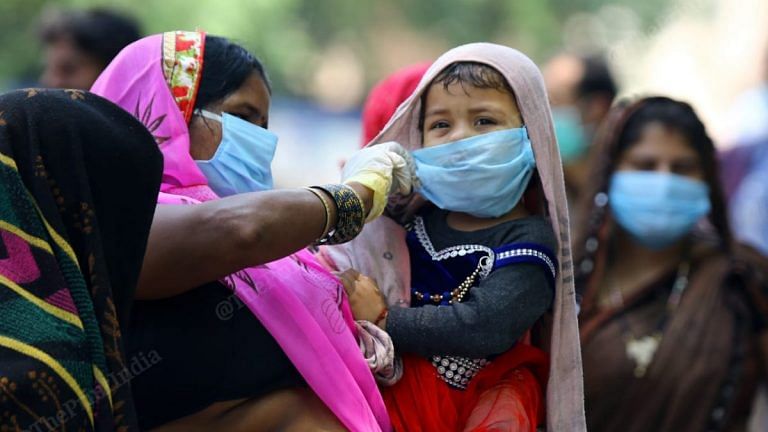New Delhi: The reports of outbreaks of respiratory illness — mainly affecting children — from several countries in Europe, as well as the US have alarmed many, especially since they closely followed a similar outbreak in China.
In some countries, the disease is being called ‘white lung syndrome’, giving the impression that it may be a new condition and thus triggering concerns of other outbreaks in a world recently battered by the Covid pandemic.
But health authorities and clinicians in India maintain that there is no need to panic yet, and no new pathogen or disease-causing agent has been identified as the cause of the recent surge in pneumonia cases.
Dr Sandeep Nayar, principal director and head of department, pulmonology, with BLK-Max Super Speciality Hospital, pointed out that, in China, the overwhelming number of pneumonia cases could be a result of infections, including influenza or those caused by adenoviruses and the respiratory syncytial virus (RSV) — all of which are associated with respiratory symptoms.
“There are also reports of increase in Mycoplasma pneumonia or infections, which are known to cause atypical pneumonia (pneumonia caused by different bacteria than the more common ones that cause pneumonia), or white lung syndrome,” he told ThePrint.
But ‘white lung syndrome’ is not a new disease, and it is only the symptomatic manifestation of a viral or bacterial infection.
Also Read: Govt closely monitoring H9N2 case, pneumonia outbreak in China, but ‘low risk to India’
What is white lung syndrome?
When we get a chest X-ray or CT scan, Nayar said, the lungs — filled with air — appear black in colour, as the air allows radiation to pass through it without blocking it.
“If there is any infection or any other pathology like fluid in lungs, then that portion blocks part of the radiation and, hence, causes a whitish impression on chest X-rays and CT scans,” he said.
Nayar said any infection in the lungs may be termed white lung syndrome — it is not medical terminology, but broadly represents lung pathology.
According to Mumbai-based infectious disease specialist Dr Ishwar Gilada, the white lung syndrome is a generalised term for acute respiratory distress syndrome (ARDS), which can be secondary to infection or to any lung pathology that is severe.
Currently, the term is widely used for pneumonia cases that are being diagnosed in China, Nayar said, adding that there has been a sudden spurt of lung infection cases, predominantly in children, in China.
“It is quite contagious and spreading very fast in the community and hence causing a lot of fear among the public,” he added.
But, according to Dr Kirti Sabnis, an infectious disease specialist with Fortis Hospital in Mumbai, at present, the white lung syndrome is primarily linked to viral pneumonia, often caused by flu or other respiratory viruses prevalent in China during specific seasons.
“However, it’s essential to note that sporadic cases of flu also occur, and they can be effectively managed with appropriate medications and intensive care,” she said.
Symptoms and ways to prevent and manage it
The syndrome is marked by cough, fever, sweating, chills and, in some cases, shortness of breath.
Gilada said children aged 3-8 years may be more susceptible to it.
Like cases of serious flu infection, patients of this syndrome, in most cases, can be effectively managed with appropriate medications and intensive care.
“Also, there is a vaccine — meant to protect against pneumonia — available. This vaccine is particularly beneficial for individuals with compromised immunity or those prone to recurrent chest infections,” Sabnis said.
Does India need to worry yet?
On 23 November, The Lancet Microbe published a report, ‘Mycoplasma Pneumonia: Delayed re-emergence after Covid-19 restrictions’, which said that the All India Institute of Medical Sciences (AIIMS) in New Delhi had detected seven cases of the bacterial infection between April and May this year.
But the Union health ministry in a statement issued Thursday clarified that these seven cases had no link to the recent surge being reported in respiratory infections from other parts of the world, including China.
“The seven cases have been detected as a part of an ongoing study at AIIMS Delhi in the six-month period and are no cause for worry,” the ministry said.
The statement also stressed that, from January 2023 to date, no case of Mycoplasma pneumonia was detected in 611 samples tested at the AIIMS-Delhi department of microbiology as part of the Indian Council of Medical Research’s (ICMR’s) multiple-respiratory-pathogen surveillance. The samples primarily (95 percent) included severe acute respiratory infection (SARI) cases.
SARI, according to the World Health Organization (WHO), is “an acute respiratory infection with history of fever or measured fever of ≥ 38°C and cough, with onset within the last 10 days, and requiring hospitalisation”.
According to the government, M pneumonia is the commonest bacterial cause of community-acquired pneumonia, and is the reason for nearly 15-30 percent of all such infections.
Such a surge has not been reported from any part of India, the government statement said, stressing that the ministry is in touch with state health authorities and is keeping a close watch on the situation on a daily basis.
Clinicians, however, said while there is no need to be alarmed at present, the country does need to be cautious.
“We must continue to take precautions as whatever the causal agent may be, these respiratory infections spread via droplets through air only,” Nayar said.
He added that it may be beneficial to wear masks and maintain social distance as far as possible and it is also a good idea to practise hand hygiene and get annual flu shots.
“I would also recommend anyone having respiratory symptoms to consult their doctor and avoid going into a crowded area or school or office as it may spread to others,” Nayar also said.
(Edited by Sunanda Ranjan)
Also Read: Marked rise in sudden deaths & heart attacks in 2022, shows NCRB data

